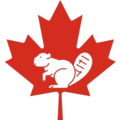Portal:Canada
| Showcase | Contents | Contributing |
Introduction
Canada is a country in North America. Its ten provinces and three territories extend from the Atlantic Ocean to the Pacific Ocean and northward into the Arctic Ocean, making it the world's second-largest country by total area, with the world's longest coastline. Its border with the United States is the world's longest international land border. The country is characterized by a wide range of both meteorologic and geological regions. With a population of just over 41 million people, it has widely varying population densities, with the majority residing in urban areas and large areas of the country being sparsely populated. Canada's capital is Ottawa and its three largest metropolitan areas are Toronto, Montreal, and Vancouver.
A developed country, Canada has a high nominal per capita income globally and its advanced economy ranks among the largest in the world by nominal GDP, relying chiefly upon its abundant natural resources and well-developed international trade networks. Recognized as a middle power, Canada's strong support for multilateralism and internationalism has been closely related to its foreign relations policies of peacekeeping and aid for developing countries. Canada promotes its domestically shared values through participation in multiple international organizations and forums. (Full article...)
Featured article -
The Battle of Quebec (French: Bataille de Québec) was fought on December 31, 1775, between American Continental Army forces and the British defenders of Quebec City early in the American Revolutionary War. The battle was the first major defeat of the war for the Americans, and it came with heavy losses. General Richard Montgomery was killed, Benedict Arnold was wounded, and Daniel Morgan and more than 400 men were taken prisoner. The city's garrison, a motley assortment of regular troops and militia led by Quebec's provincial governor, General Guy Carleton, suffered a small number of casualties. (Full article...)
Current events
- April 16, 2025 – Tariffs in the second Trump administration
- California Governor Gavin Newsom and California Attorney General Rob Bonta file a lawsuit against U.S. President Donald Trump and his administration over the tariffs, making California the first U.S. state to do so. The lawsuit also targets the International Economic Emergency Powers Act, the law used by Trump to impose tariffs against Canada, China, and Mexico. (Politico)
- April 15, 2025 –
- Four people are injured in a vehicle-ramming attack after a person drives a sedan onto a pedestrian walkway on the Toronto Metropolitan University campus near Yonge Street and Gerrard Street in Toronto, Ontario, Canada. (CBC News)
- April 9, 2025 – Tariffs in the second Trump administration, Executive orders in the second presidency of Donald Trump
- Canada announces a 25% tariff on certain vehicle imports from the U.S. as retaliation against a previous similar measure from the U.S. (BBC News)
- April 3, 2025 – Tariffs in the second Trump administration
- Multinational car manufacturer Stellantis announces it will lay off 900 workers across five of its U.S. factories and will pause production at assembly plants in Canada and Mexico in response to the tariffs. (Reuters)
- April 3, 2025 – Canada convoy protests
- The Ontario Court of Justice in Ontario, Canada, convicts Tamara Lich and Chris Barber, two leaders of the truck driver protest movement against COVID-19 vaccination in Canada, of criminal mischief. (AP)
- April 2, 2025 – Tariffs in the second Trump administration
- China–United States trade war, 2025 United States trade war with Canada and Mexico
Selected panorama -
National symbol -

An inuksuk (plural inuksuit) or inukshuk (from the Inuktitut: ᐃᓄᒃᓱᒃ, plural ᐃᓄᒃᓱᐃᑦ; alternatively inukhuk in Inuinnaqtun, iñuksuk in Iñupiaq, inussuk in Greenlandic) is a type of stone landmark or cairn built by, and for the use of, Inuit, Iñupiat, Kalaallit, Yupik, and other peoples of the Arctic region of North America. These structures are found in northern Canada, Greenland, and Alaska (United States). This combined region, north of the Arctic Circle, is dominated by the tundra biome and has areas with few natural landmarks. (Full article...)
Selected vital article -
Canadian cuisine consists of the cooking traditions and practices of Canada, with regional variances around the country. First Nations and Inuit have practiced their culinary traditions in what is now Canada for at least 15,000 years. The advent of European explorers and settlers, first on the east coast and then throughout the wider territories of New France, British North America and Canada, saw the melding of foreign recipes, cooking techniques, and ingredients with indigenous flora and fauna. Modern Canadian cuisine has maintained this dedication to local ingredients and terroir, as exemplified in the naming of specific ingredients based on their locale, such as Malpeque oysters or Alberta beef. Accordingly, Canadian cuisine privileges the quality of ingredients and regionality, and may be broadly defined as a national tradition of "creole" culinary practices, based on the complex multicultural and geographically diverse nature of both historical and contemporary Canadian society. (Full article...)
Selected picture -
Featured biography -
Louis Alexander Slotin (/ˈsloʊtɪn/ SLOHT-in; 1 December 1910 – 30 May 1946) was a Canadian physicist and chemist who took part in the Manhattan Project. Born and raised in the North End of Winnipeg, Manitoba, Slotin earned both his Bachelor of Science and Master of Science degrees from the University of Manitoba, before obtaining his doctorate in physical chemistry at King's College London in 1936. Afterwards, he joined the University of Chicago as a research associate to help design a cyclotron. (Full article...)
Did you know -

- ... that journalist W. A. Hewitt refereed the first game played in the history of ice hockey at the Olympic Games?
- ... that celebrities who were interviewed in The Canadian Conspiracy were paid US$500?
- ... that in 2019, the Canadian government's Translation Bureau began providing translation services in Dene, East Cree, Plains Cree, and Mohawk?
- ... that the Saskatchewan Conservation House, built in 1977 to withstand Canadian winter temperatures, did not use a furnace?
- ... that Theo Benedet is the first offensive lineman to be named the best Canadian university football lineman two years in a row?
- ... that the first Miss Indigenous Canada contestants were judged on ambassadorship, character, community service, and cultural involvement?
- ... that the only populated place on Kaipokok Bay in Labrador, Canada, is Postville?
Featured list -
The Lionel Conacher Award is an annual award given to Canada's male athlete of the year. The sports writers of the Canadian Press (CP) first conducted a poll to determine the nation's top athlete, of either gender, in 1932. Separate polls for the best male and female athletes were conducted beginning the following year. The CP formalized the poll into an award in 1978, presenting their winner a plaque. It was named after Lionel Conacher, a multi-sport champion whom the news organization had named its top athlete of the half-century in 1950. The award is separate from the Northern Star Award, in which a select panel of sports writers vote for their top overall athlete. (Full article...)
Main articles
Associated Wikimedia
The following Wikimedia Foundation sister projects provide more on this subject:
-
Commons
Free media repository -
Wikibooks
Free textbooks and manuals -
Wikidata
Free knowledge base -
Wikinews
Free-content news -
Wikiquote
Collection of quotations -
Wikisource
Free-content library -
Wikiversity
Free learning tools -
Wikivoyage
Free travel guide -
Wiktionary
Dictionary and thesaurus






























